7 Steps for Prioritizing Feature Requests +Top 10 Factors
Last updated on Thu Oct 16 2025
Every SaaS team gets flooded with feature requests. The real challenge is choosing the right ones. Knowing how to prioritize feature requests can mean the difference between a product that scales and one that stalls. If you listen to every request, your roadmap turns into a mess.
If you ignore too many, your users churn. This guide is here to help you strike the balance.We’ll walk you through a clear, step-by-step process for organizing, evaluating, and actioning the feature requests that matter most, without losing sight of your product vision.
Along the way, we’ll explore popular prioritization frameworks like RICE and Weighted Scoring, and show you how tools like Frill can simplify the entire workflow.Whether you’re a SaaS founder, product manager, or the person quietly doing both jobs, this guide will help you build a product that your users love (and your team can actually ship).
Let’s get into it.
What are feature requests and why they matter in SaaS
Feature requests are the heartbeat of a customer-led SaaS product. They represent direct input from users about what they want your product to do. When collected and prioritized properly, these requests can reveal patterns, validate demand, and fuel meaningful product improvements. But not all feedback is a feature request, and not every request should make it to your roadmap.
Feature requests vs general feedback
Not all user input belongs in your product backlog. A feature request is a suggestion for a new capability or functionality—something the product doesn’t currently do. Think: “Add SSO support,” “Let me duplicate a project,” or “Integrate with Slack.”
In contrast, general feedback might include bug reports, usability gripes, performance issues, or vague comments like “the dashboard feels clunky.” These are valuable too, but they belong in a different workflow. The key is tagging and organizing feedback early so your team can focus on what’s actionable.
How feature requests fuel product strategy
When handled right, feature requests help SaaS teams stay customer-centric without getting distracted. They support your product vision, reduce churn, improve user experience, and increase long-term loyalty.
Why prioritizing feature requests is hard
Every SaaS team wants to build what customers want. But knowing what to build next and what to ignore is where it gets complicated. With hundreds (sometimes thousands) of feature requests coming from every direction, the process of prioritization becomes more art than science. It requires filtering, scoring, and aligning. And that’s where things get messy.
Common challenges
These are the difficulties most product teams face:
Conflicting internal vs external opinions: Your users may be shouting for one thing, while your CEO has a totally different vision. Internally, it’s easy for leadership to push priorities that feel disconnected from what customers are actually asking for. Balancing what users want with what your business needs is no small feat.
Sales vs product team vs customer success inputs: Sales teams often push for features that help close deals. Customer success teams champion what's needed to reduce churn. And product teams want to focus on scalable improvements. When everyone has a different lens, prioritization quickly becomes a political battleground.
Data overload or lack of structure: Feature requests flood in through support tickets, Slack, emails, social DMs, and meetings. Without a centralized system to collect and categorize them, requests get lost, or worse, duplicated and forgotten. A lack of structure leads to a backlog that’s impossible to act on.
What happens when you get it wrong
Failing to prioritize strategically can lead to some major problems like:
Roadmap bloat: When you try to build everything for everyone, your product becomes unfocused and hard to maintain.
Wasted dev time: Shipping low-impact features just because they were requested can burn engineering time that could’ve gone to high-leverage work.
Product drift from vision: Over-prioritizing “popular” requests can pull your product in too many directions, slowly eroding the original strategy that made it valuable in the first place.
How to prioritize feature requests step by step (main “how-to” section)
There’s no shortage of feature requests in SaaS. The real challenge is turning them into a clear, focused roadmap that actually serves your users and your business. That’s where structured prioritization comes in.
Step 1. Centralize all feature requests
If your requests are scattered across support tickets, Slack threads, and inboxes, you’re already losing. The first step is getting everything into one centralized place so you can actually evaluate it.
This doesn’t have to be complicated. Create a single source of truth where all feature ideas live. Something that's visible to your team, searchable, and ideally, connected to your users.
A few reasons this matters:
No duplicate ideas
Easier trend spotting
Clear ownership
Faster decisions
Here’s a quick snapshot of what a centralized system might include:
Public feature request board
In-app widget
Internal tagging system
Voting or polling mechanism
Roadmap integration
Tools like Frill make this stupidly simple. You can spin up a feature request board in minutes, add it to your app with a widget, and start collecting ideas with user context (and votes) attached.
If you're comparing tools, we've put together a breakdown of the best feature request tools here.
Don’t skip this step. A messy inbox might feel manageable at first, but it scales terribly. Get organized now so you don’t regret it later.
Step 2. Categorize & tag feature requests
Once your requests are centralized, it’s time to clean them up. Start tagging each request by product area, user type, and effort type (low-hanging fruit vs deep dev work). This makes it way easier to filter, sort, and spot trends later—especially when your backlog hits triple digits.
Frill makes this part easy with built-in tags, duplicate detection, and the option to mark private ideas for internal use only. You’re not just organizing for today, you’re building a system that scales with your product. Treat your request board like a product in itself: structured, intentional, and easy to navigate.
Step 3. Apply scoring or prioritization frameworks
Now that your requests are cleaned up and categorized, it’s time to apply some structure. This is where scoring frameworks come in. These give you a repeatable way to evaluate requests based on impact, effort, strategic fit, or all of the above. No more gut-feel prioritization. No more “we’ll circle back to it.”
Here are a few solid frameworks to consider:
RICE
Value vs Effort
MoSCoW
Weighted Scoring
Frill’s Priority Matrix
If you’re not sure which to use, we break them all down in this guide to feature prioritization matrices.
Here’s what this looks like in Frill: you define your scoring categories (Reach, Impact, Effort, etc.), assign weight to each one, then evaluate each request directly in the idea board. Once scored, you can visualize it in the Priority Matrix, making it easy to spot quick wins and high-effort investments at a glance.
Use a system like this consistently and you’ll build features that actually move the needle, not just the ones that got the most upvotes this week.
Step 4. Align with product vision & strategy
Just because a feature request is popular doesn’t mean it belongs on your roadmap. Before greenlighting anything, ask: Does this support our long-term product vision? If it’s a distraction—even a well-upvoted one—it’s okay to say no (politely). Strategic alignment is what separates great products from bloated ones.
This step is where a lot of teams slip. They get pulled in by the noise instead of staying focused on what drives retention, revenue, or differentiation.
Need a deeper dive on filtering for impact? Check out our guide on how to prioritize customer feedback.
Step 5. Involve the right stakeholders
Prioritization isn’t a solo sport. It’s a team exercise, one that needs input from the people closest to the customer and the product. Involving the right voices early prevents roadblocks later and helps you make smarter, more balanced decisions.
At minimum, you’ll want to include:
Product team
Engineering
Customer success
Sales
Each group brings a different lens: product sees the big picture, engineering knows feasibility, customer success speaks for user pain points, and sales understands what moves deals forward.To keep everyone aligned (and sane), connect your tools.
Frill’s integrations with Slack, Jira, and Intercom make collaboration painless:
Discuss requests in Slack
Push priorities into Jira
Pull context from Intercom
Cross-functional input leads to better, faster product decisions.
Step 6. Visualize your priority matrix
Once you’ve scored your feature requests, the next move is to visualize the data. A spreadsheet full of numbers doesn’t tell a story. A priority matrix helps you instantly spot what’s worth building now, what needs more thought, and what’s probably not worth your time.
In Frill, all your scored requests automatically feed into a visual matrix. It maps each request based on your benefit and cost ratings, making prioritization feel a whole lot less abstract.
You’ll quickly identify:
Quick wins
Big investments
Little satisfiers
Time wasters
This kind of visualization isn’t just for product managers. It’s an easy way to get buy-in from execs, engineering, and other stakeholders without needing a 20-slide deck.
Step 7. Communicate & close the loop
Prioritization doesn’t end when a decision is made, you’ve got to close the loop. When users take the time to submit feedback, they want to know it actually went somewhere. Keep them in the loop with clear, consistent updates via your changelog, announcements, and public roadmap.
Tools like Frill’s announcement widget make it easy to share what’s shipping (and why). You don’t need a big product launch to say “we heard you.” A simple update builds trust, improves engagement, and encourages more feedback, which keeps the whole cycle running. Want inspiration? Here are some standout changelog examples.
10 Factors to consider when prioritizing feature requests
Let’s be honest: most feature requests sound reasonable at first glance. But if you acted on all of them, your product would turn into a Frankenstein backlog of edge cases, distractions, and duplicate functionality.
That’s why smart prioritization comes down to knowing what to look for, and what to filter out.
Below are 10 criteria that can help you gut-check every request before it makes its way onto the roadmap.
1. User upvotes
Upvotes aren’t everything, but they are a signal. If a feature is getting consistent love from real users (not just your team voting on behalf of customers), it’s worth investigating. Just make sure you’re not only chasing what’s loudest. Upvotes show demand, not necessarily value.
Frill’s upvoting system lets you see not just the number of votes, but who’s asking, which is just as important.
2. Strategic alignment with product vision
A feature can be popular and still be completely wrong for your product. If it doesn’t fit your long-term vision, it’s a distraction, no matter how shiny it looks in the short term.
Use this as your filter:
Does it align with our core positioning?
Does it solve a problem we actually want to own?
Will it help differentiate us in the market?
Or are we just trying to copy competitors?
This is the “say no gracefully” stage.
3. Roadmap timing and dependencies
Sometimes a feature would be valuable, just not right now.
If a request depends on infrastructure or functionality you haven’t built yet, it may need to wait. Or maybe it would block a planned initiative if you pushed it forward now.
Look at:
Current sprint plans
Upcoming launches
In-flight features
Backend limitations
Timing matters more than most people think. Saying “not yet” is just as valid as saying “no.”
4. Revenue potential / upsell opportunities
Not all requests are created equal, especially when some directly tie to expansion revenue.
If a feature helps you close a major deal, increase ARPU, or improve retention for high-paying customers, that bumps it up the list fast.
Examples worth flagging:
Upsell triggers
Feature-gated premium tiers
Add-ons for power users
Custom features for enterprise clients
Just be careful not to turn your product into a consulting service disguised as SaaS.
5. Requested by top customers or key segments
One upvote from your highest-value customer might be worth 50 from free users. That’s just the math.
But this only works if you segment your request board intelligently. Frill makes it easy to tag requests by customer type, MRR tier, or segment — so you’re not guessing.
Pro tip: use this filter sparingly. A feature that works for one big account but hurts the rest of your customer base still isn’t worth building.
6. Urgency
Some features are urgent. Others are just nice-to-haves dressed in all caps.
Urgency means there’s pain happening right now. Maybe it’s breaking workflows. Maybe it’s a blocker to onboarding. Maybe your support team is drowning in tickets because it’s missing.
Look for:
Blocking issues
Broken workflows
Repeated support tickets
Dev team bottlenecks
Urgency doesn’t always equal priority — but combined with impact, it becomes a strong case.
7. Developer effort
You need to know how long something will take before you commit to building it. A feature might be high value, but if it takes three months to implement and burns out your entire dev team, you’ve got to ask: is it worth it right now?
Get rough estimates for:
Engineering time
Backend vs frontend lift
Test coverage needs
Technical debt cleanup
Use this to weigh features on your value vs effort matrix, not to kill them outright — but to make smarter tradeoffs.
8. Cross-team dependencies
Some requests sound simple… until you realize they touch four systems and three departments.
Any feature that requires coordination across teams — product, engineering, design, legal, marketing, etc. — comes with extra friction. Not a dealbreaker, but definitely something to factor in.
The more moving parts, the more risk of delay, confusion, or misalignment.
If it’s a low-impact feature with high coordination cost? Probably not worth it.
9. Expected user impact
This is where you pull back from votes and think about real-world usage. How many users will this help? Will it improve core workflows? Does it remove friction in a high-touch part of the app?
Look for signals like:
Feature adoption data
Support ticket themes
User research interviews
NPS driver analysis
If something is low effort and high impact across a large user segment, that’s your sweet spot. Prioritize accordingly.
10. Market/competitive advantage
Sometimes you build something not because users are asking for it, but because it gives you an edge.
Maybe a competitor just released a flashy feature you know your users will ask about. Maybe there’s an industry trend emerging you want to get ahead of.
Consider:
Competitive gaps
Feature parity (when needed)
Differentiators that support your brand
Category leadership opportunities
5 frameworks you can use to prioritize feature requests
Once your backlog is organized and tagged, the next move is scoring requests, and doing it consistently. This is where prioritization frameworks come in. They help remove guesswork and gut decisions by giving your team a structured way to rank ideas based on value, effort, or strategic alignment.
The right framework depends on your product stage, team size, and how much data you have available. Let’s walk through five of the most popular.
1. RICE Framework
RICE (Reach, Impact, Confidence, Effort) is one of the most widely used scoring systems in SaaS, and for good reason. It balances user value with cost and risk in a way that’s simple to understand, but powerful in practice.
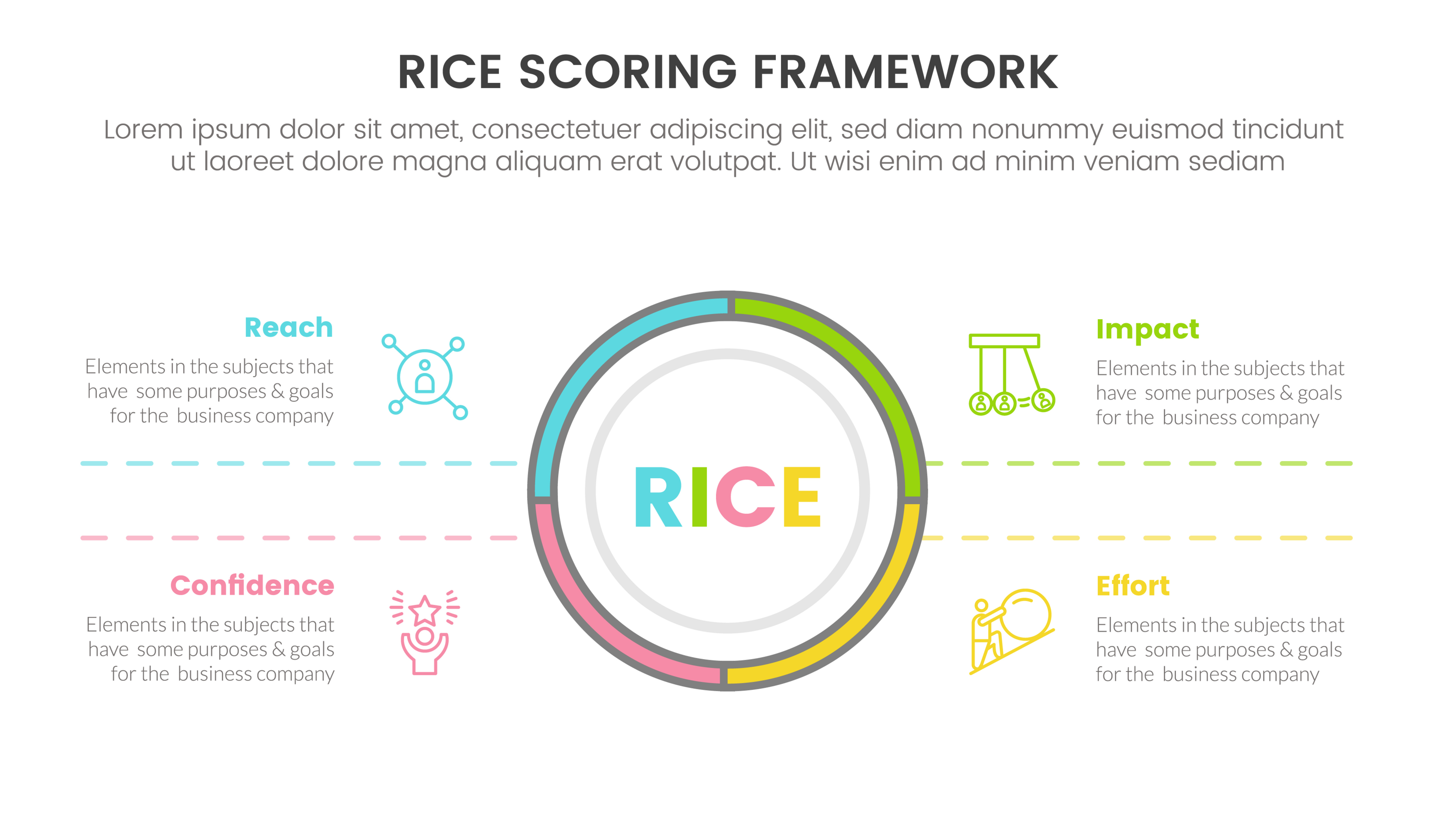
Each feature is scored using:
Reach: How many users will benefit?
Impact: How much will it improve their experience?
Confidence: How sure are we about the first two?
Effort: What’s the time and resource cost to build it?
Frill makes it easy to implement RICE by letting you set custom weights, rating types, and track everything directly in your request board. Use this framework when you’ve got enough data to make reasonable estimates.
2. Value vs Effort Matrix
If you want a lightweight version of RICE, this is it. The Value vs Effort matrix helps you visualize tradeoffs by boiling features down into just two factors: how much value they deliver and how hard they are to build.

It’s perfect when you need fast prioritization without all the math. Ideal for smaller teams or early-stage products where some structure is better than none.
Frill supports this matrix out of the box. Just assign a value score, an effort score, and see how everything maps visually.
Use this when:
You’re in rapid iteration mode
You’re working with limited data
You want to highlight “quick wins” fast
3. MoSCoW Model
MoSCoW helps teams align on urgency and importance without over-complicating the process.
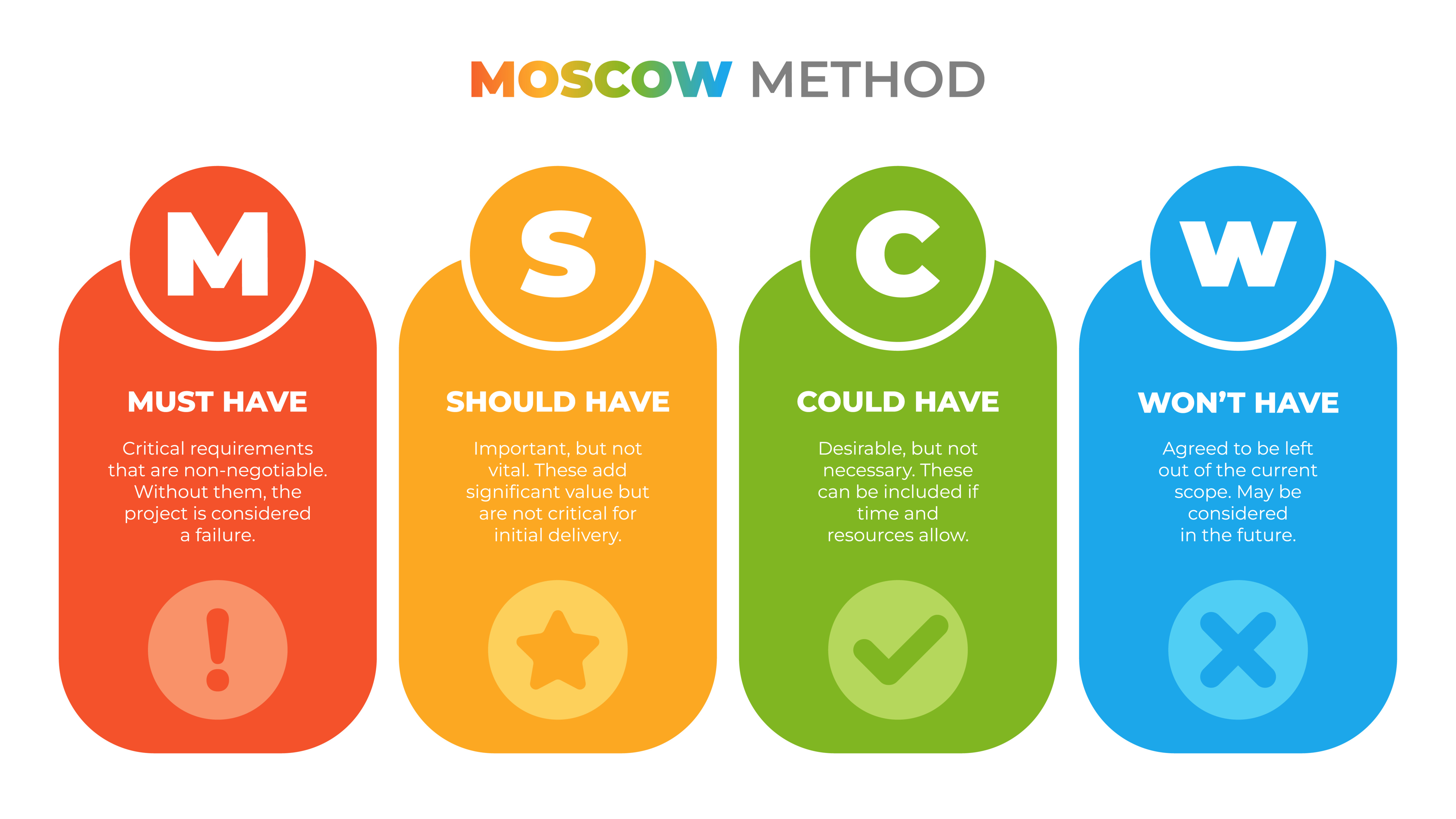
Break features into:
Must-have
Should-have
Could-have
Won’t-have (for now)
This framework is especially useful during sprint planning or roadmap reviews where time is limited and you need fast agreement on priorities.
While Frill doesn’t have a dedicated MoSCoW view, you can simulate it with tags or custom fields and still use the matrix to visualize priorities.
Use this when you’re in roadmap mode, not scorecard mode. It’s quick, it’s clear, and it forces tough conversations early.
4. Weighted Scoring
Weighted scoring is for teams who want full control over how requests are evaluated. You decide the benefit and cost factors, assign custom weights to each one, and let the math do the work.
Common benefit factors:
User votes
Strategic fit
Impact
Customer segment
Common cost factors:
Dev time
Technical complexity
Cross-team dependencies
Frill makes it simple to build your own weighted system. Once set up, you can score each feature directly from the request board and immediately see how it stacks up in the visual matrix.
This is a great choice for growing product teams that want consistency without being locked into someone else’s framework.
5. Frill’s Visual Priority Matrix
If you want structure and speed, Frill’s Priority Matrix gives you the best of both. It lets you score requests using whatever criteria you want (RICE, Value vs Effort, Weighted Scoring — all of it works), then automatically plots them on a matrix so you can visually identify:
Quick wins
Big investments
Low-value distractions
High-effort risks
It’s the “what should we build next?” view you wish your backlog always had.
No spreadsheets. No guessing. Just a clear picture of what matters — and what doesn’t.
Here you can see how feature requests can be plotted across costs and benefits:
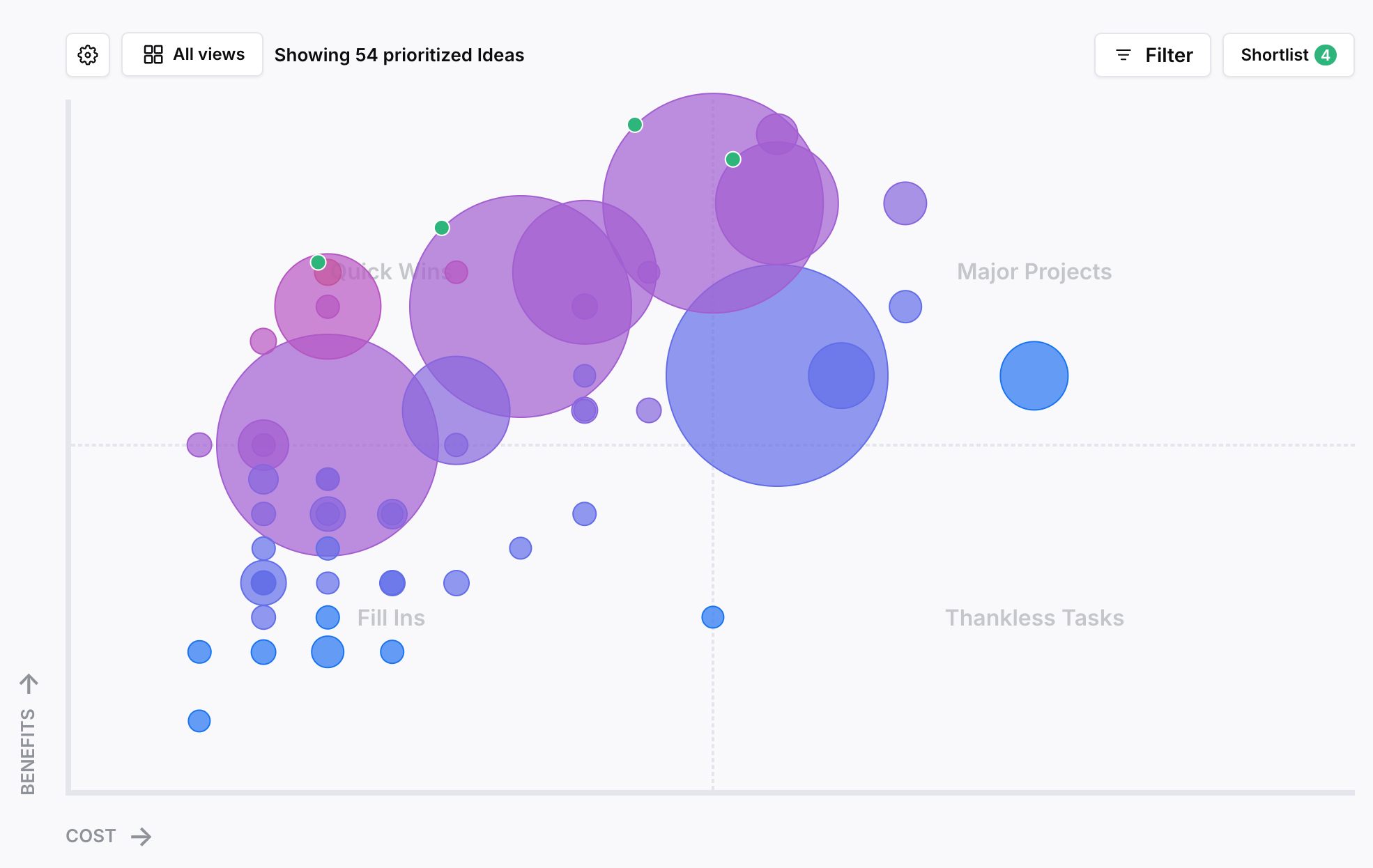
And here, you can see that trends and categories of requests can be identified automatically:
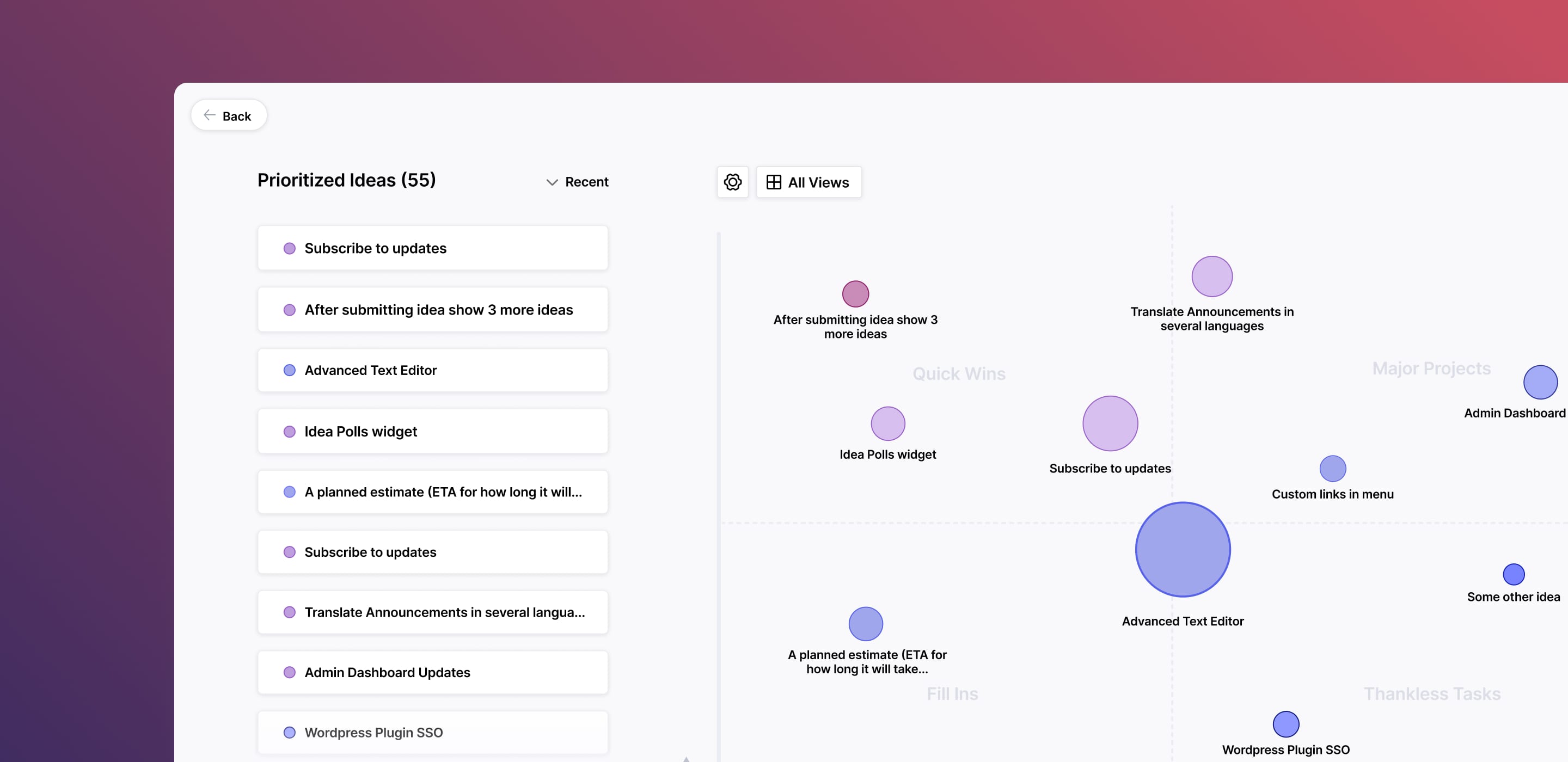
Best tools for managing feature request prioritization
You don’t need a dozen tools to manage feedback, but you do need one that centralizes input and gives you a clear way to prioritize.
You can use your favorite product feedback software to track incoming requests and analyze them.
Below are some great options for collecting, organizing, and acting on feature requests.
1. Frill
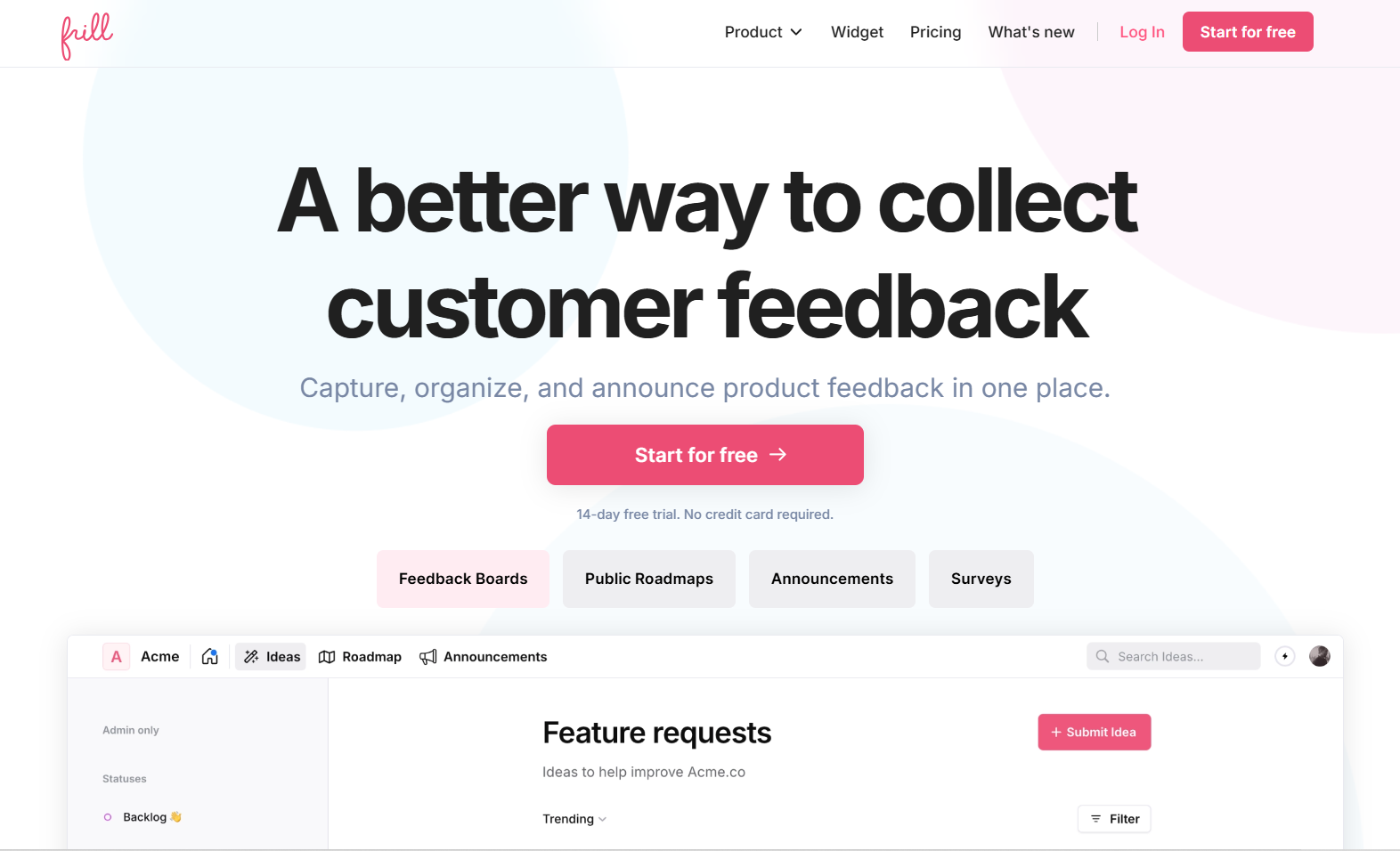
Frill is a beautifully simple yet powerful tool built specifically for managing customer feedback and prioritizing feature requests. It combines idea capture, roadmapping, announcements, and a fully customizable feature prioritization matrix, all in one clean, distraction-free interface.
You can score requests based on your own benefit vs. cost factors, auto-surface high-impact ideas, and visualize them instantly with Frill’s visual Priority Matrix.
Frill works as both a hosted web app and embeddable widget, integrates with tools like Intercom, Jira, and Slack, and includes public voting, changelogs, and roadmap views. It’s ideal for SaaS teams that want serious feedback workflows without the enterprise bloat.
2. Productboard
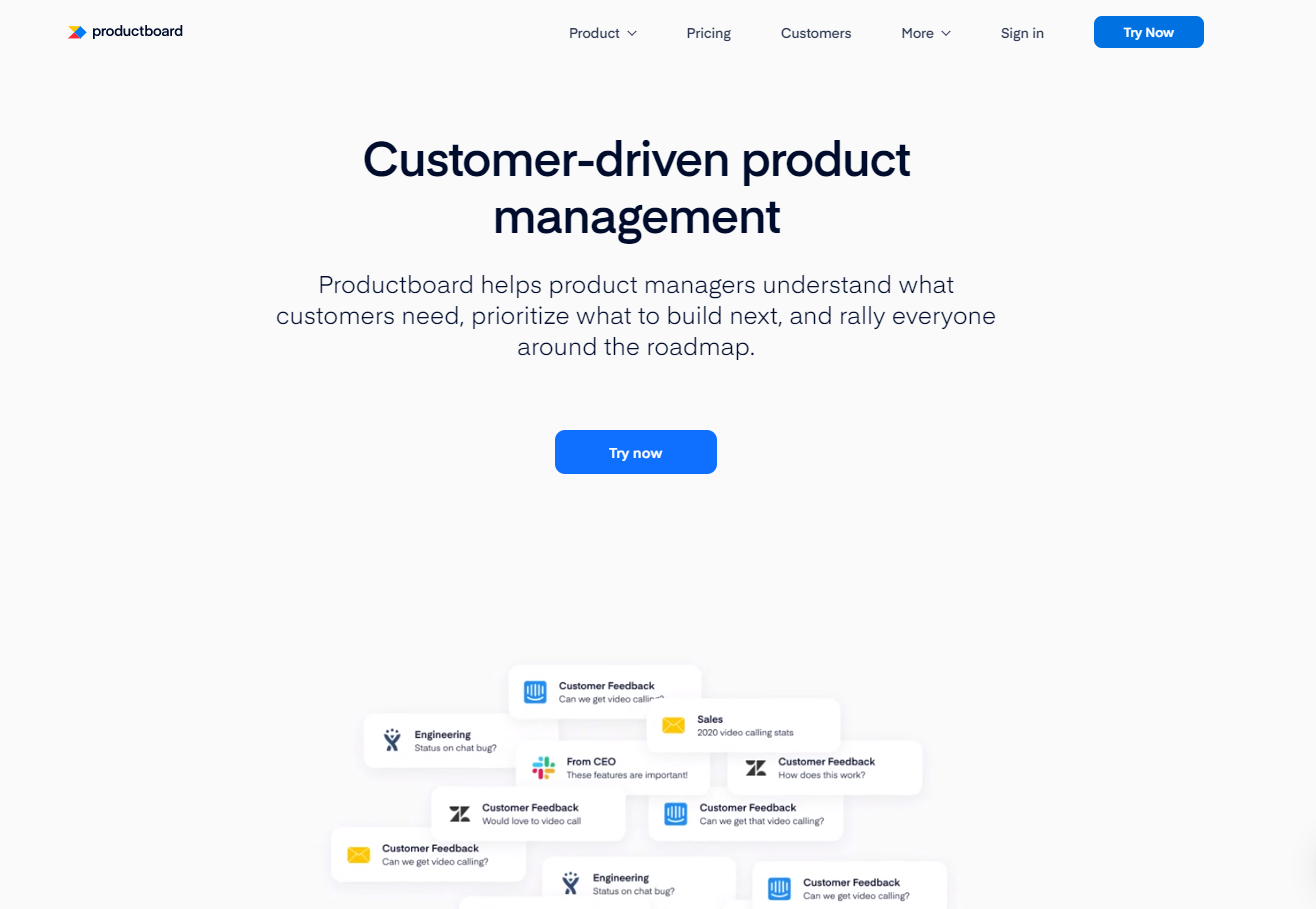
Productboard is a robust product management suite that includes feedback collection, prioritization, and roadmap planning. It’s great for larger teams with complex workflows and deep integration needs. You can connect user insights to product objectives, score features across multiple criteria, and use internal portals for team input.
It’s overkill for some, but powerful if you need all-in-one planning and cross-functional collaboration in one place. Great for scaling teams juggling multiple products or personas.
3. Canny
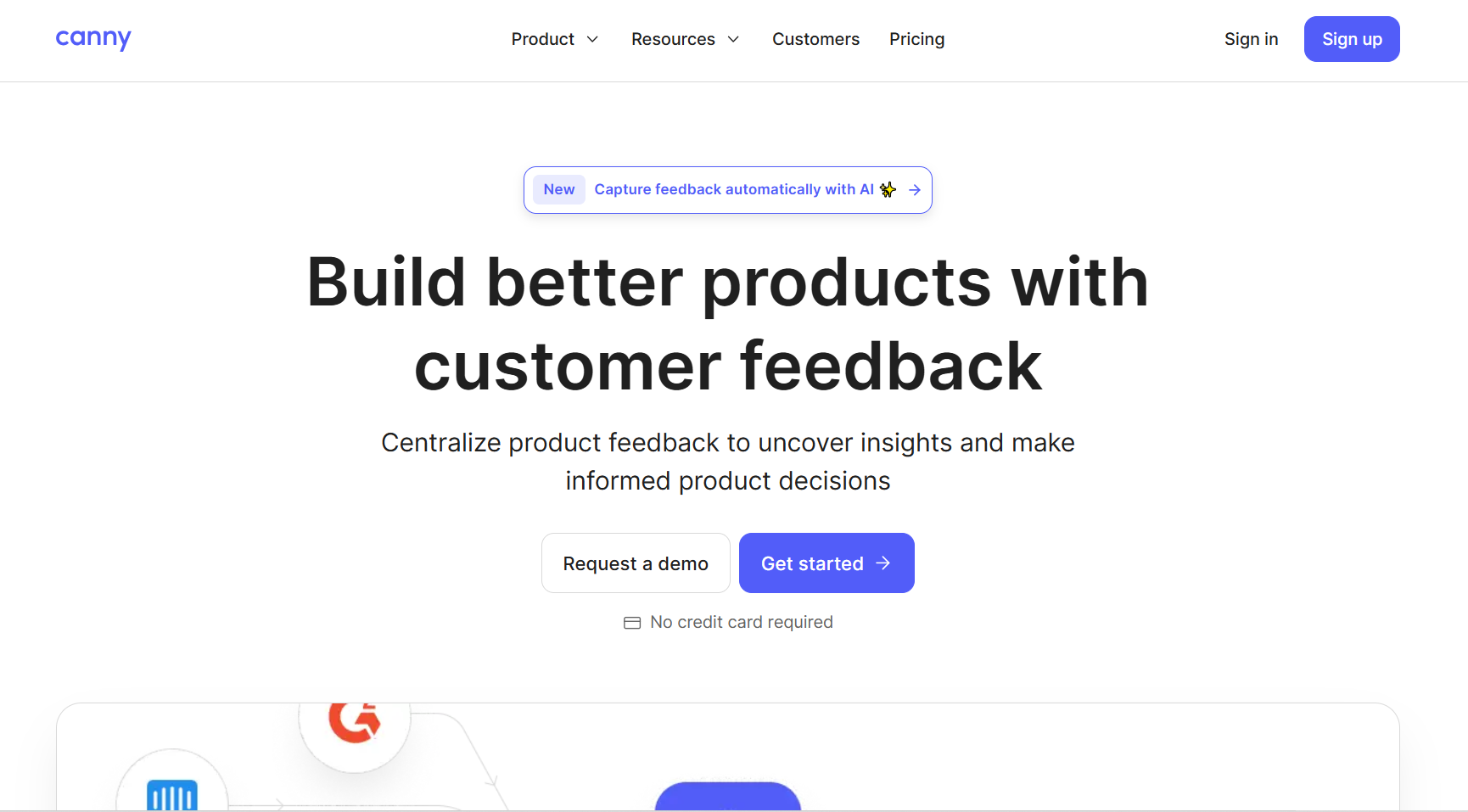
Canny offers public and private feedback boards, upvoting, status updates, and roadmap visibility. It’s a solid middle ground, because the platform is more structured than basic tools, but simpler than enterprise platforms. You can tag feedback by customer segment, assign status, and track which features are driving the most interest.
Canny also includes basic prioritization options and integrates with tools like Intercom, Slack, and GitHub. A good choice for teams that want visibility without too much overhead.
4. Jira
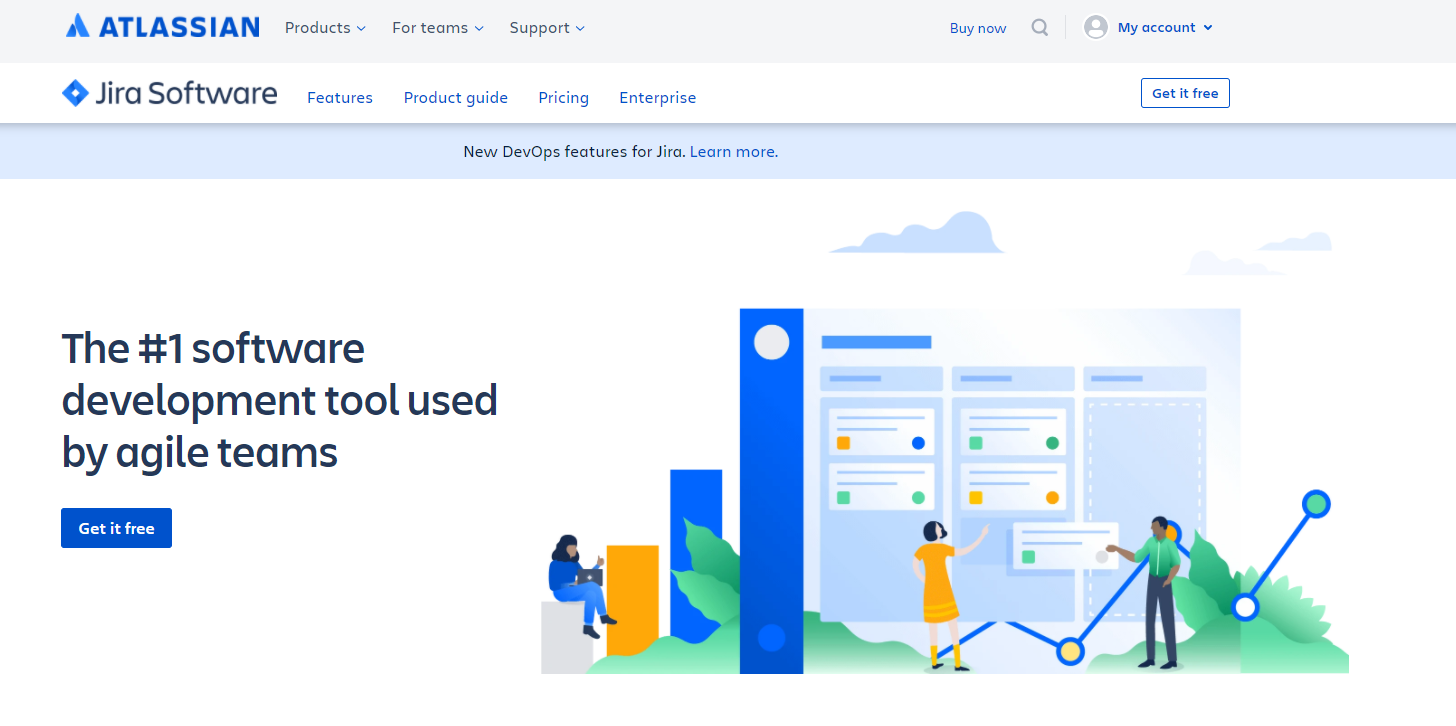
Jira isn’t a feedback tool, but it’s where prioritized feature requests often end up. It’s the dev team’s home base for task management and sprint planning. Once you’ve scored or selected high-priority requests in Frill, Productboard, or Canny, sending them to Jira keeps engineering aligned and accountable.
Most feedback tools integrate with Jira natively, making handoff seamless. Don’t use Jira to collect feature requests, use it to ship them.
5. Help desk (Intercom, Zendesk, HelpScout)
Support teams are on the front lines of customer feedback. That’s why integrating your feature request tool with Intercom, Zendesk, or HelpScout is a no-brainer. It lets agents capture requests directly from conversations, tag relevant ideas, and vote on behalf of users, without switching tools.
This keeps feedback flowing in naturally and ensures your prioritization includes insights from actual pain points and recurring issues. It’s one of the easiest ways to turn support into a strategic product signal.
5 mistakes to avoid when prioritizing feature requests
Request prioritization is so important. It affects every aspect of your business. As renowned German writer Wolfgang von Goethe says, you don't want to let what matters get blocked by what doesn't.
"The things that matter most should never be at the mercy of the things that matter least.” – Johann Wolfgang von Goethe
Here are some ways to make sure this doesn't happen to your team:
1. Listening to the loudest voices
Just because someone shouts the loudest (or pays the most) doesn’t mean their request should jump the queue. Prioritizing based on volume skews your product away from what benefits most users. Look at patterns, not outliers. The goal is impact, not appeasement.
2. Letting sales dictate the roadmap
Sales teams have valuable insights, but turning your roadmap into a deal-closing wishlist leads to feature bloat. Prioritize what solves core problems for many, not custom one-offs. Otherwise, you risk building a Frankenstein product that pleases no one in the long run.
3. Prioritizing without user validation
Feature requests aren’t always what users really need, just what they say they want. Before you greenlight anything, validate it with usage data, interviews, or support trends. Otherwise, you’ll waste dev time building features that don’t solve real problems.
4. Overcomplicating frameworks
It’s easy to get lost in spreadsheets, scoring models, and prioritization debates. Don’t let the process become a bottleneck. Use simple, effective frameworks (like RICE or Value vs Effort), and adapt as needed. Prioritization should help you move faster, not slow everything down.
5. Ignoring effort constraints
A feature might be a perfect fit… until engineering sees the timeline. Ignoring dev effort or technical limitations leads to delays, burnout, and frustration. Always loop in engineering early and weigh complexity against value. Smart tradeoffs build momentum.
Build what matters, not just what’s asked
At the end of the day, great products aren’t built on every request, they’re built on the right ones. Structured prioritization keeps your team focused, efficient, and aligned with your product vision. You don’t need to say yes to everything; you just need to choose wisely.
Frill makes the process simple. Collect, score, and visualize feature requests all in one place. Start your free trial and start building what truly matters.